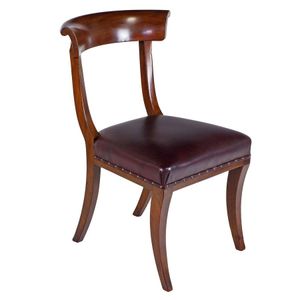Regency Sabre Leg Mahogany Dining Chairs (Set of 7)
Good set of seven Regency sabre leg mahogany dining chairs in the classical Klismos style circa 1820, one shown
You must be a subscriber, and be logged in to view price and dealer details.
Subscribe Now to view actual auction price for this item
When you subscribe, you have the option of setting the currency in which to display prices to $Au, $US, $NZ or Stg.
This item has been sold, and the description, image and price are for reference purposes only.
- Klismos Chair - The Klismos chair was originally developed by the ancient Greeks in the 5th century BC. The design with a rectangular curved back and concave tapeing legs was revived during the Regency period. Versions were made for the Earl of Harewood for the refurbished Entrance Hall at Harewood House, c. 1805.
- Sabre Leg - The sabre leg is commonly associated with chairs made in the Regency or classical revival manner of the early 19th century. The form was copied from designs of the ancient Grecian chair known as a klismos found on painted classical vases. The characteristic of the sabre leg is a wide, sweeping backward curve which was frequently reeded, similar to a sabre. The sweep of the front legs was sometimes complemented by a corresponding curve in the back legs of the chair, though on most domestic furniture the sweep of the rear support was not as pronounced. Sabre legs are often encountered in reproductions of the regency style. They are uncommon in Australian furniture where, by and large, colonial craftsmen preferred to use turned legs.
- Circa - A Latin term meaning 'about', often used in the antique trade to give an approximate date for the piece, usually considered to be five years on either side of the circa year. Thus, circa 1900 means the piece was made about 1900, probably between 1895 and 1905. The expression is sometimes abbreviated to c.1900.
- Regency Period - The Regency period in English furniture design refers to the period when King George III, was declared unfit to rule in 1811, and his son ruled as proxy as Prince Regent, until 1820, and then, after the death of his father as George IV until his death in 1830. The Regency period was preceded by the Georgian period (George I, George II, and George III: 1714 - 1811), and was followed by the William IV period, which only lasted until 1837 when William IV died as was succeeded by Queen Victoria.
- Mahogany - Mahogany is a dense, close grained red-coloured timber from the West Indies and Central America. It was first imported into Europe in the the early 18th century and its use continued through the 19th century. It was popular for furniture making because of its strength, the wide boards available, the distinctive grain on some boards, termed flame mahogany and the rich warm colour of the timber when it was polished.. The "flame" was produced where a limb grew out from the trunk of the tree, and this timber was usually sliced into veneers for feature panels on doors, backs and cornices.
Some terms used to describe mahogany relate to the country from which it originally came, such as "Cuban" mahogany, "Honduras" mahogany etc. However unless the wood has been tested the names assigned are more a selling feature, rather than a true indication of the timber's origin.
This item has been included into following indexes:
Visually similar items

Victorian mahogany dining chair with blue leather upholstery, circa 1860
Sold by
in
for
You can display prices in $Au, $US, $NZ or Stg.

Regency period mahogany dining chair with brown leather upholstery, circa 1820
Sold by
in
for
You can display prices in $Au, $US, $NZ or Stg.

William IV mahogany dining chair, circa 1835
Sold by
in
for
You can display prices in $Au, $US, $NZ or Stg.

An Australian cedar spade back dining chair with tapering hexagonal legs, c1840
Sold by
in
for
You can display prices in $Au, $US, $NZ or Stg.
